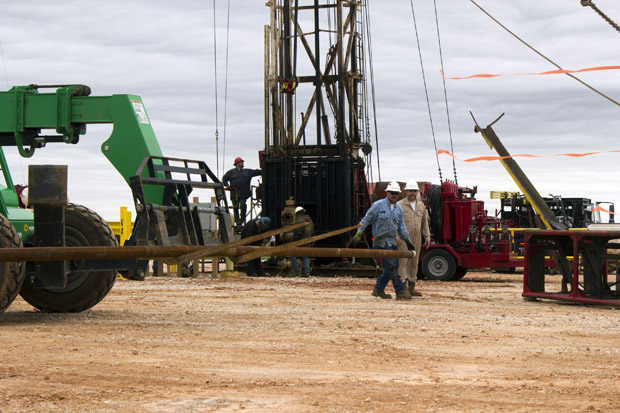
Oil-field workers lining up a section of pipe at a disposal well in Grant County, Okla.
Joe Wertz / StateImpact Oklahoma


Oil-field workers lining up a section of pipe at a disposal well in Grant County, Okla.
Joe Wertz / StateImpact Oklahoma

Joe Wertz / StateImpact Oklahoma
Oil-field workers lining up a section of pipe at a disposal well plug-back operation in Grant County, Okla.
The vast majority of Oklahoma’s recent earthquakes occurred in areas where the energy industry pumped underground massive amounts of waste fluid byproducts of oil and gas production, scientists write in a new paper published Thursday.
Conversely, regions with relatively low amounts of waste fluid injection have experienced comparatively few earthquakes, doctoral student Rall Walsh and geophysics professor Mark Zoback, both of Stanford University, write in “Oklahoma’s Recent Earthquakes Linked to Saltwater Disposal,” a paper published in the journal Science Advances.
The new research adds to a growing body of scientific evidence linking Oklahoma’s earthquake surge to wells used by the oil and gas industry.
Briny, chemical-laden waste fluid is a byproduct of oil and gas production. To keep the toxic fluid from contaminating land and sources of drinking water near the surface, energy companies pump it into disposal wells, which trap it deep underground. Once injected, the fluid builds pressure and spreads underground, where it can contact fractured rock formations, “unclamp” faults and release centuries of stored tectonic stress, Zoback says.
“Thousands of years of earthquakes are occurring in just a few years in Oklahoma due to this massive injection of produced water,” he says.
To study how fluid injection correlates to earthquake activity, Walsh and Zoback focused on six regions in Oklahoma: Three areas experiencing a lot of earthquakes, and three adjacent and equally sized areas that are less seismically active.
The research shows that the earthquakes are more likely triggered by waste fluid injection than other types of fluid injection, such as enhanced oil recovery wells or “waterflooding” operations, where extracted fluid is re-injected underground to pressurize and help push oil to production wells.
The three quake-prone regions — areas near Cherokee, Jones and Perry — account for 71 percent of Oklahoma’s earthquakes, 27 percent of the state’s total volume of waste fluid disposal, and show a “clear” connection between increased rates of fluid disposal and elevated earthquake occurrence, the research shows.
Two of the less seismically active areas, Enid and Oklahoma City, had recorded much less waste fluid disposal. The third of the less seismically active areas, near Ardmore, had “appreciable” levels of fluid injection, but nearly all the injection was into enhanced oil recovery wells, the researchers found.
By re-injecting waste fluid into the same formation from which it came, “you avoid increasing the pressure at depth,” Zoback says. For regulators and the oil industry, the science suggests that oil industry waste fluid might pose less of an earthquake risk if it were re-injected back into the same formation it was pumped out of.
Make disposal wells more like enhanced oil recovery wells, basically.
“Scientifically that’s a solution, but whether it’s practical and economically feasible” is a decision for the oil industry and regulators, Zoback says.
The new research also suggests Oklahoma’s earthquake surge has been fueled by the cumulative pressure generated by many waste fluid disposal wells. Most of that fluid is injected into an underground formation known as the Arbuckle, which underlies most of the state.
“What’s happening is really this regional or large-area response to many wells,” Zoback says. “The pressure spreads out and the earthquake occurs where the fault is.”
The pressure can trigger earthquakes from faults that are miles away from injection wells, this and other research show. In some cases, there can be a substantial lag time between fluid injection and the onset of earthquakes, the research suggests.
“It takes a few years for the pressure to spread out in the Arbuckle, find the faults, penetrate to depth, and for the earthquakes to occur,” Zoback says.
Wells’ and Zoback’s research also underscores the potential risk of injecting fluid into granite basement rock, which is located just below the popular Arbuckle disposal zone.
Oklahoma’s oil and gas regulator has been zeroing in on those potentially risky disposal wells, too. In March, the Corporation Commission ordered the operators of 357 wells to prove they weren’t injecting into basement rock, “plug back” their well to a shallower depth or reduce their waste fluid injection.
As of mid-June, 127 wells have been plugged back or are in the process of being plugged back; 86 were proven to not be contacting basement rock; the rest of the wells were inactive or operating with reduced volumes, records from the Corporation Commission show.
Most of the earthquakes are small, but many can be felt. Some scientists have linked the 5.7-magnitude quake that struck near Prague, Okla., in November 2011 and injured people to disposal wells. The magnitude and damage caused by the Prague quake gives scientists and officials some indic
“It’s more than just a nuisance, it’s a problem that has to be dealt with,” Zoback says.
In a separate study published Thursday in the journal Science, researchers linked an “unprecedented increase” in earthquakes throughout the Central United States — including Oklahoma, Arkansas, Colorado, Illinois and Texas — to injection wells. The paper suggests high-rate injection wells — the ones that pump more than 300,000 barrels per month — are much more likely to trigger earthquakes than low-rate injection wells.